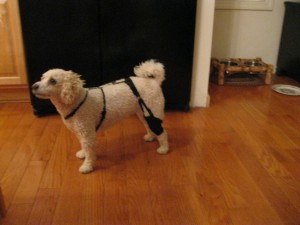My 5 year old Pomapoo Foxy partially tore her left ACL 6 months ago. I cannot bear the thought of putting her through a painful surgery when her symptoms were never debilitating. She started with a limp upon arising. After she would walk for a few minutes then the limp would go away and she would walk normally.
Other symptoms I would notice were a slight hop when galloping and she would wave her leg around while sniffing and leaning forward. My husband and I decided to try conservative management even though 2 vets recommended surgery. We quickly realized that she is far to active to totally restrict her outbursts of playing, so we ordered a knee brace from mutt knee brace about 3 months ago.
She is doing well with the brace, most of her unstable symptoms improved. The only thing I still notice is toe touching for the first few seconds upon waking. She will stand up and dangle her leg until she stretches. While I’m happy with her progress, I’m scared because this shows that there is still an injury.
I know for a fact if she was a calmer dog she would be healed by now. I have got her weight down 3 lbs and she still has another pound or so to go. I also give her ENP glucosamine plus for dogs. I still don’t want to put her through surgery, in which the risks outweigh the extent of her problem, but I want my dog back to her old self.
Also, if we are failing to keep her totally calm now, how will we do it for surgery recovery? There seems to be no good option. I want to start taking her places again and not be worried about her knee all the time. My dog is my baby, I just want to do the right thing for her. Does anyone have suggestions for better supplements or a natural anti inflammatory or anything I can further do holistically?


I don’t know how long you have been trying conservative management, but it takes about 8 weeks of restricted activity to see any improvement. Also, the weight loss and supplements will only “kick in” after a few weeks too. I think we all have problems with being patient when our dogs are lame like this! It’s very difficult, like having to care for a baby! I also have a small dog (Pom/Lhasa) with a ruptured cruciate ligament and have been doing LOTS of research. The first couple of weeks we let her hop here and there but then we learned that we have to really restrict her activity for at least 8 weeks if we want her to heal without surgery, and if we don’t want the other leg’s ligament to rupture too. This means we have been putting her on the bed while we dress, on the sofa while we watch TV, in a pet stroller while we eat or cook, and right now she’s on an upholstered chair as I’m typing on the computer. The only time she walks is when she’s on the sofa (a few steps) and when we bring her out to do her duties and we now use a short leash because we don’t want her hopping more than a few steps. This is what we’ve been doing for about 3 weeks but now our holistic vet has told us we should set up some baby gates and create a carpeted area for her (about 4′ x 4′ or so) where she can see our activity (like in the living/dining area) but she can walk a few steps, drink her water, chew her bone, etc. In other words, she has been confined to rest for a few weeks but now it’s important at this stage that she start putting some weight on the injured leg if she can (but not too much, hence the space restriction). If she can’t after two weeks or so, we will have to consider surgery. Needless to say, we have been doing our best with high quality glucosamine/chondroitin/MSM supplementation, as well as Omega oil, acupuncture, K-laser, massage, Traumeel to reduce inflammation, and she is getting Cartrophen injections which help reduce inflammation, encourage cartilage growth, and help stop the enzyme responsible for arthritis. (Why don’t doctors offer this to us?!). All of this extra care is not cheap (about $900 plus the gas to drive there, an hour away, twice a week), however seeing a real vet (but holistic) on a bi-weekly basis is really giving us the support we need because this dog is also our “only child”. We can’t tell if her muscles are starting to atrophy or if her inflammation is better or worse but the vet can, and it’s worth every penny to have a qualified and conscientious person following our dog’s progress so closely. She even has the underwater treadmill that will help the dog’s rehab process when the time comes, surgery or not. But the bottom line is that conservative management requires time and patience, and we really have to restrict their activity. Life will never be the same for us or our dog – we don’t ever want her to be jumping up to her bench beside the window so we will add a ramp; the deck will also have a ramp. Now that this has happened, we want to protect both her legs to avoid re-injury and also to prevent the second leg from a rupture (she has a luxation so she’s susceptible). It’s not the end of the world, we’ll just have to be careful to keep her from jumping and stair climbing which is not that hard since we live in a one-story home and she’s never been extremely active except when the mailman comes (they’re all the same!). But from all the research I’ve done, if your dog is very active maybe the surgery is the best best, and it seems TPLO is better for the more active dogs. All the best! You’re not alone in your sadness and frustration! Looks like we make up a “great crowd”! This is the #1 injury for dogs! In other words, we should just start every dog on glucosamine, omega oil, etc. as soon as possible!!! More prevention should be done if this is so common.